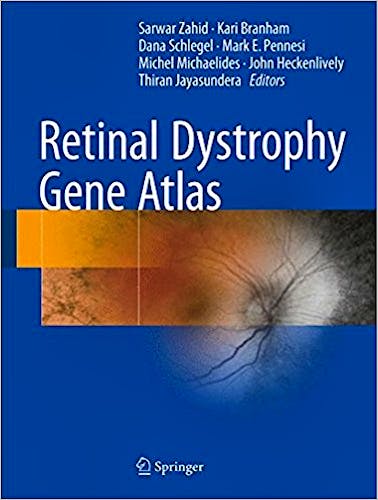

No hay productos en el carrito



Retinal Dystrophy Gene Atlas
Zahid, S. — Branham, K. — Schlegel, D. — Pennesi, M. — Michaelides, M. — Heckenlively, J. — Jayasundera, T.
1ª Edición Julio 2018
Inglés
Tapa dura
275 pags
896 gr
22 x 29 x 2 cm
ISBN 9783319108667
Editorial SPRINGER
LIBRO IMPRESO
-5%
207,99 €197,59 €IVA incluido
199,99 €189,99 €IVA no incluido
Recíbelo en un plazo de
2 - 3 semanas
LIBRO ELECTRÓNICO
-5%
176,79 €167,95 €IVA incluido
169,99 €161,49 €IVA no incluido
Acceso On Line
Inmediato
- Describes a gene and all its possible clinical phenotypes and patient characteristics, along with retinal photos depicting each possible phenotype
- Written by prominent retinal dystrophy specialists from the largest dystrophy centers worldwide
- Contains more than 80 chapters, each of which describes the clinical and photographic manifestations of a specific gene
- Includes stunning clinical color photographs of the retina, autofluorescence imaging, and electrophysiologic findings and cross-sectional imaging
- Serves as a resource to aid genetic diagnosis in patients with retinal dystrophies by retina specialists and pediatric ophthalmologists in the United States, as well as hundreds of fellows and residents that enter the workforce each year
Classically, photo atlases of retinal dystrophies have been divided into sections that describe and depict a particular retinal finding or disease, after which a differential diagnosis of potential diseases or mutated genes is provided. However, given the pace of improvement in molecular diagnostics, availability of free mutation screening from the NIH, and the exponential increase in our understanding of the phenotypes caused by each mutated gene, the paradigm has changed to where physicians now think of variable expression of each individual gene. Therefore, Retinal Dystrophy Gene Atlas catalogs the different phenotypes that are possible with each mutated gene. Each section describes a gene and all its possible clinical phenotypes and patient characteristics, along with retinal photos depicting each possible phenotype. Written by prominent retinal dystrophy specialists from the largest dystrophy centers worldwide, Retinal Dystrophy Gene Atlas contains more than 80 chapters, each of which describes the clinical and photographic manifestations of a specific gene. The chapters are organized into one of three sections based on the inheritance pattern (Autosomal Dominant, Autosomal Recessive, or X-linked) and will include stunning clinical color photographs of the retina, autofluorescence imaging, and electrophysiologic findings and cross-sectional imaging. Retinal Dystrophy Gene Atlas serves as a resource to aid genetic diagnosis in patients with retinal dystrophies by more than 2,400 retina specialists and pediatric ophthalmologists in the United States, as well as hundreds of fellows and residents that enter the workforce each year.
Sarwar Zahid, MS, MDUniversity of Michigan Kellogg Eye CenterAnn Arbor, MI, USA
Kari Branham, MS, CGC University of Michigan Kellogg Eye CenterAnn Arbor, MI, USA
Dana Schlegel, MS, MPH, CGC University of MichiganKellogg Eye CenterAnn Arbor, MI, USA
Mark Pennesi, PhD, MDCasey Eye InstitutePortland, OR, USA
Michel Michaelides, MB, MDMoorfields Eye HospitalLondon, United Kingdom
John Heckenlively, MDUniversity of Michigan Kellogg Eye Center Ann Arbor, MI, USA
Thiran Jayasundera, MDUniversity of Michigan Kellogg Eye CenterAnn Arbor, MI, USA
© 2025 Axón Librería S.L.
2.149.0